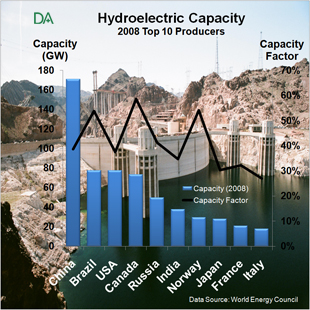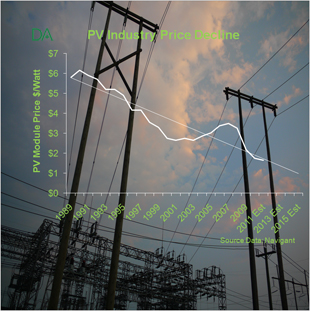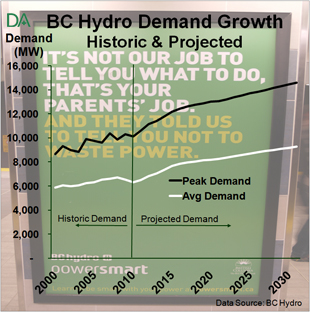As discussed at the recent CanSIA Solar West Conference, when hydropower is compared to PV power on a value basis, the results are surprising.
PV today can be more economical than hydropower.
Hydropower is considered to be the most economic way to generate electricity today, and provides almost one-fifth of the world’s electricity. Solar PV, on the other hand, is widely considered to be an expensive source of electricity though its costs are dropping rapidly.
A closer look at one of the biggest hydro projects on the drawing board in North America, however, suggests that hydro may actually be more expensive than solar PV on a comparable value basis.
PV may already be the lowest cost alternative.
Evaluating PV on value
When evaluating costs of electricity generation, solar PV installations are typically compared against average, or levelized, costs of electricity from conventional sources. Such comparisons distort the economic picture and lead to erroneous conclusions.
The cost of PV generated electricity should be looked at the other way around, and evaluated on the specific value of the energy produced.
PV has high peak coincidence
Solar PV generation is highly coincident with typical daily peak demand. As a result, solar generation offers higher value than is captured in a simple levelized comparison. Peak demand normally accounts for roughly 5 to 15% of electricity demand and is typically the most expensive power to provide.
PV has seasonal match with hydro
Just as demand is not uniform, neither is hydroelectric power generation. There are seasonal and year-to-year variations in water inflow and hydroelectric capacity. Hydro reservoirs are typically at their lowest levels just before spring runoff. In North America, this is normally in the March-May timeframe.
PV generation does vary over the year – and can offset hydro reservoir cycles. Even in British Columbia, with its northern latitudes, some locations have their highest solar potential during this same March-May timeframe when reservoirs are typically at their lowest levels.
Rather than take a simple cost-based approach to Solar PV generation, it makes more sense to compare Solar PV on the basis of its value. When new hydro facilities are compared to peak and seasonal values of solar PV generation, PV can be more the more economic choice.
BC Hydro Site C
Canada is one of the world’s largest producers of hydroelectric power, and its hydro facilities boast some of the highest capacity factors, or load factors, in the world.
In the province of British Columbia, roughly 90 percent of electrical power comes from hydroelectric facilities. The government-owned electrical utility BC Hydro is a world expert in construction and operation of hydroelectric power plants.
BC Hydro is planning to add a major new dam. First identified as a resource in the 1950s, ‘Site C’ on the Peace River has long been a target of controversy – as have other large projects such as the Three Gorges Dam.
While steering clear of that debate, an assessment of the economics of Site C as compared to current and near-term projected solar PV costs is revealing. As a gigawatt (GW) scale facility, Site C is an instructive example of the current economics of new, large-scale hydropower projects.
Surprisingly, the current economics of Solar PV compare favorably with the costs as well as the expected construction time and operation of the Site C dam. Comparing the two on the most basic measure, cost per watt, Site C is estimated to cost twice as much at $7.18/watt as a new PV installation today at $3.81/watt.
PV projects installed today can recover their costs even before Site C is completed – and already represent a more economic alternative. Where Site C and other hydropower projects face the risk of cost overruns, solar continues to drop dramatically and capacity can be added incrementally. What may be marginally economic today for PV over hydro will be even more attractive next year.
PV projects are faster and cheaper
The Site C project is expected to require ten years to complete and cost $7.9 billion, or $7.18/watt. Started in 2010, Site C is slated to start production in 2020. A lot can happen in that timeframe, including the growth of peak electricity demand. Where Site C faces realistic risks of cost overruns, solar PV continues a decades-long price reduction.
PV can be installed incrementally in lock-step with load growth, with the expectation that next year’s PV supply will be less expensive than this year’s.
The equivalent PV resource is available at $3.81/watt today and can be added in large PV parks, on rooftops, or both. PV can be located nearby the proposed hydro project, or close to the load and bypass any need to add transmission or distribution infrastructure for load growth.
In a dispersed deployment, solar generation has been demonstrated to be a highly predictable resource.
New demand incurs new costs and higher utility debt
Whether BC Hydro applies a ‘specific facility’ accounting for its generation costs, or an averaging based upon total capacity, the ratepayer will be impacted by the costs of the additional peak power supply. The higher the cost of satisfying new demand, the higher will be the resulting electricity rates.
When a utility adds new generation, the costs become new utility debt that the ratepayers are ultimately liable for. In the case of a government-owned utility such as BC Hydro, that debt is effectively also a taxpayer liability.
PV installations are typically installed with third-party financing, and do not add debt to the utility’s balance sheet. They are constructed and managed by third-party developers and operators. Typical contract structures require payment only for the electricity that is delivered.
PV projects would not place any debt on BC Hydro’s books. Moreover, BC Hydro’s ratepayers would not be liable for any interest costs during construction.
Peak demand growing faster than baseload
New electricity demand is driven by economic and population growth, along with increased standard of living and new technologies such as electric vehicles. The balance of peak demand to baseload is not constant with increasing demand. In North American jurisdictions, such as California, it is not unusual for peak demand to grow faster than baseload demand. In fact, this has been a decades-long trend.
Counter-intuitively, energy efficiency programs have actually contributed to lower load factors and higher peak demand.
The BC Hydro forecast for peak demand anticipates a 30% growth between 2010 and 2020, and will exceed the anticipated capacity of the Site C facility. While peak and average load are projected to grow at similar rates in percentage terms, the actual peak demand increments are considerably larger than average load.
Peak demand and peak power exports
A further opportunity for PV generated electricity is related to the seasonality of peak demand. BC has a winter peak, while California and most of the US has a summer peak driven by air conditioning loads.
In the summer months, BC Hydro can export electricity at a profit to California. Due to the offsetting peak timing, and the relative value of PV generation in BC, adding PV in BC would allow more profitable exports in the summer. This is true even if the costs of PV generation in California are lower than they might be in BC.
Economic comparison
Depending upon how Site C would actually operate, even at today’s cost levels PV pencils out as a potentially attractive option for BC Hydro.
Load following operation, including peak supply, is the norm for all of BC Hydro’s hydro facilities. Typically baseload supply is imported from thermal power plants in the US, and peaking power is exported from BC Hydro. From an economic perspective, as the newest or ‘last-in’ electricity source, Site C can be evaluated as a source of peak supply.
Comparison as a source of peak power generation only (i.e. head-to-head comparison)
|
Site C Hydro
|
PV
|
|
|
Cost/watt
|
$7.18
|
$3.81
|
|
Cost/kWh (12.5% c.f.)
|
34.5 ¢/kWh
|
29 ¢/kWh1
|
|
Project duration
|
10 years
|
< 1 year
|
|
Utility debt increase
|
$7.9b
|
$0
|
|
Flooded area
|
5,340 ha
|
0 (rooftop)
|
|
Lifetime
|
100 yr
|
25 yr warranty
|
|
Delivery costs
|
Transmission & Distribution
|
$0 – same (depends on location) |
|
Risks
|
Cost overruns, construction delays, operational, climate, environmental
|
Pay for delivered power
|
1For Vancouver-based rooftop projects. Lower cost in other locations.
Sources: BC Hydro, Solarbuzz, NRCan
At BC Hydro’s discount rate (8%), a revenue stream that is seven years out is only worth 58% of a revenue stream that starts today. The PV industry has well demonstrated the speed of installation, and an equivalent amount of PV generation could readily be installed within a year.
Site C must be financed by BC Hydro, whereas PV installations are typically financed by third parties. BC Hydro must cover the interest payments on the Site C debt whether the facility generates as expected or not. The Site C project also faces risks of approval delays, construction cost overruns and delays, operational issues or variable water levels.
Cost overruns on the order of 50% are ongoing challenges for current hydro projects in Manitoba and Ontario.
Standard PV contracts include payment only for energy delivered. Construction, operation and financial risk are borne by the project developer and owner.
Synergies of PV and Hydro
It isn’t necessarily a zero sum game to choose between PV and a hydropower project like Site C.
Combining PV & Hydro allows more energy market flexibility and possibly even better economics for the utility’s ratepayers. The utility does not have to incur additional financing or construction risks to combine the advantages of PV generation and hydropower.
BC Hydro, with its tremendous hydro resources, is in the enviable position of being able to leverage higher value from installed PV than a typical developer or even many other utilities. If there is a high value to extract from PV generation, that value could be derived by a utility like BC Hydro throughout the entire hydropower facility construction period.
If utilities consider the value of peak generation from PV, there is a persuasive case for committing to PV now. BC Hydro and other utilities should consider installing new PV generation to cover the incremental peak demand.
Further financial gains for BC Hydro are available. These include adding PV generation to facilitate incremental power exports of carbon neutral electricity – and receive both revenues for high value peak power and carbon credits. Unlike sales of electricity in BC, exported clean energy will benefit from carbon credits.
If utilities are serious about providing inexpensive power to their ratepayers, they should strongly consider leveraging PV now. As PV continues to drop in price, the economics of PV for peak power are already a compelling advantage.
2 Responses to “When Solar PV is Less Expensive than Cheap Hydro”
Trackbacks/Pingbacks
- When Solar PV is Cheaper than Hydro | - [...] full article here. This entry was posted in Interesting Reads and tagged PV, solar. Bookmark the permalink. [...]








An excellent post, and a discussion that needs to be had in this province! This should be reprinted in the Vancouver Sun, and other local media. Most people are completely unaware of the facts that you’ve posted above. I’m somewhat connected to the renewable energy industry in BC, and even I wasn’t aware of the reality you pointed out above.
Keep up the good work.
Thanks for this good analysis. Solar panels are just $2/Watt to as low as $1/watt for thin film. Quotes for the whole system, ie: racks, wiring, inverter in Vancouver brings costs to $7/watt to $10/watt. Whilst solar capacity cost at $7-$10/watt is similar to Site C, Site C’s capacity factor, approx 60% makes it cheaper as solar in BC, which produces its rated power about 16% of the time. I strongly oppose site C (flooding impact). BC Hydro simply does NOT invest in the demand side (energy saving) infrastructure – just publicity. A simplistic example: 30 LED lights (Philips ambientLed 12.5w) per home across BC would save 3,000 GWh 3/5 of Site C, and cost just $2.6Bn.